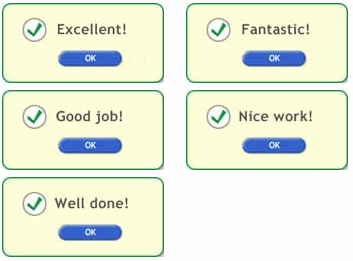Default feedback messages
Updated 28 Aug 2023
If you do not provide custom messages for short-answer interactions, your students see default feedback messages when they submit incorrect, correct, and equivalent answers.
One of the following default messages displays when students answer a question correctly.

The following default message displays when students answer a question incorrectly.

If the student enters an equivalent answer that is not in the correct form, a feedback message about the form of the answer appears. The message varies depending on the answer rule (as specified in step 1 of the Edit Answer Definition window):
Answer Rule | Conditions | Specific message |
Accept integer or decimal equivalents only | Student enters a fraction or a calculation that is equivalent to the defined solution. | Although your answer is equal to the correct answer,
it is not in the correct form. Be sure to read any instructions given
in the problem. If there are no special instructions, make sure your answer
is a whole number, an integer, or a decimal. |
Accept fully-reduced form | Student enters an answer that is not fully reduced but is equivalent to the defined solution. | Although your answer is equal to the correct answer, it is not in the correct form. Be sure to read any instructions given in the problem. If there are no special instructions, make sure your answer is simplified and entered in a fully-reduced form. |
Accept similar answer or algebraic function | The solution is a single number and the student enters an answer that is not fully reduced. | Although your answer is equal to the correct answer,
it is not in the correct form. Be sure to read any instructions given
in the problem. If there are no special instructions, make sure your answer
is a whole number, an integer, or a decimal. |
The solution is a simple fraction and the student enters a decimal equivalent or other equivalent answer not in the correct form. | Although your answer is equal to the correct answer, it is not in the correct form. Be sure to read any instructions given in the problem. If there are no special instructions, your answer must be in the form of a fraction. Make sure the numerator and denominator are in their simplest form. | |
The solution is a simple rational expression (for example, the numerator and denominator contain terms such as 2.1, x, y, or sin x), and the student enters some other form. | Although your answer is equal to the correct answer, it is not in the correct form. Be sure to read any instructions given in the problem. If there are no special instructions, make sure your answer is simplified and entered in a fully-reduced form. | |
The solution is the multiplication of two numbers and the student enters the product of the two numbers, such as 6, instead of a multiplication expression, such as 2 * 3. | Although your answer is equal to the correct answer, it is not in the correct form. Be sure to read any instructions given in the problem. If there are no special instructions, your answer must be a product of two numbers. | |
All applicable answer rules | The solution is an ordered pair and the student enters the ordered pair without parentheses. | Your answer must be in the form of an ordered pair. Make sure you have enclosed your answer in parentheses. |
The solution requires comma-formatted numbers and the student entered the correct answer without commas. | Although your answer is equal to the correct answer, it is not in the correct form. Be sure to read any instructions given in the problem. If there are no special instructions, numbers greater than 999 need to be specified with commas (for example, 1,000). | |
The student’s answer is not in correct form for a reason not defined in this table. | Although your answer is equal to the correct answer, it is not in the correct form. Be sure to read any instructions given in the problem. If there are no special instructions, make sure your answer is fully simplified. |